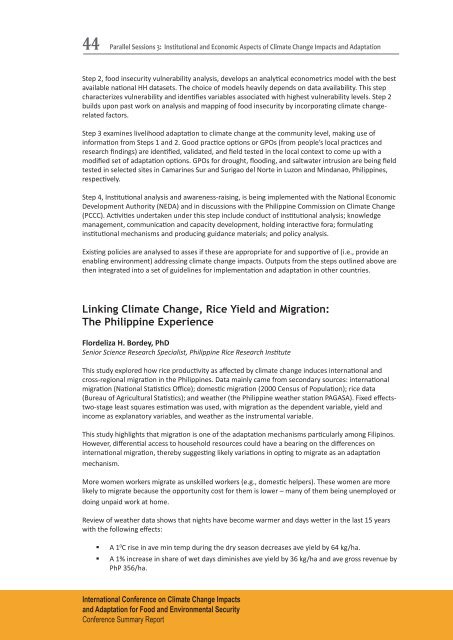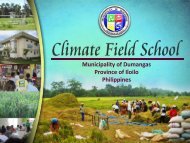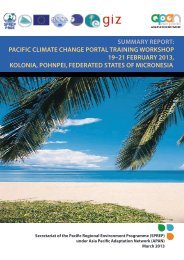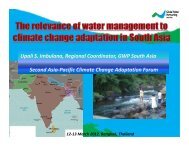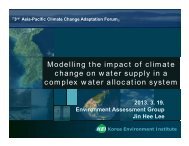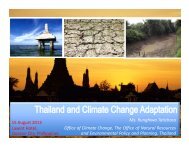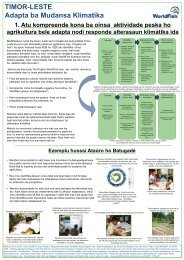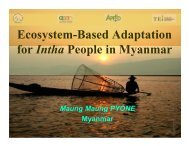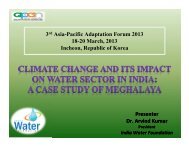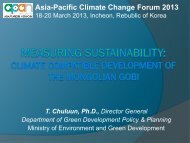PDF file (2.44 MB) - Asia Pacific Adaptation Network
PDF file (2.44 MB) - Asia Pacific Adaptation Network
PDF file (2.44 MB) - Asia Pacific Adaptation Network
Create successful ePaper yourself
Turn your PDF publications into a flip-book with our unique Google optimized e-Paper software.
44Parallel Sessions 3: Institutional and Economic Aspects of Climate Change Impacts and <strong>Adaptation</strong>Step 2, food insecurity vulnerability analysis, develops an analytical econometrics model with the bestavailable national HH datasets. The choice of models heavily depends on data availability. This stepcharacterizes vulnerability and identifies variables associated with highest vulnerability levels. Step 2builds upon past work on analysis and mapping of food insecurity by incorporating climate changerelatedfactors.Step 3 examines livelihood adaptation to climate change at the community level, making use ofinformation from Steps 1 and 2. Good practice options or GPOs (from people’s local practices andresearch findings) are identified, validated, and field tested in the local context to come up with amodified set of adaptation options. GPOs for drought, flooding, and saltwater intrusion are being fieldtested in selected sites in Camarines Sur and Surigao del Norte in Luzon and Mindanao, Philippines,respectively.Step 4, Institutional analysis and awareness-raising, is being implemented with the National EconomicDevelopment Authority (NEDA) and in discussions with the Philippine Commission on Climate Change(PCCC). Activities undertaken under this step include conduct of institutional analysis; knowledgemanagement, communication and capacity development, holding interactive fora; formulatinginstitutional mechanisms and producing guidance materials; and policy analysis.Existing policies are analysed to asses if these are appropriate for and supportive of (i.e., provide anenabling environment) addressing climate change impacts. Outputs from the steps outlined above arethen integrated into a set of guidelines for implementation and adaptation in other countries.Linking Climate Change, Rice Yield and Migration:The Philippine ExperienceFlordeliza H. Bordey, PhDSenior Science Research Specialist, Philippine Rice Research InstituteThis study explored how rice productivity as affected by climate change induces international andcross-regional migration in the Philippines. Data mainly came from secondary sources: internationalmigration (National Statistics Office); domestic migration (2000 Census of Population); rice data(Bureau of Agricultural Statistics); and weather (the Philippine weather station PAGASA). Fixed effectstwo-stageleast squares estimation was used, with migration as the dependent variable, yield andincome as explanatory variables, and weather as the instrumental variable.This study highlights that migration is one of the adaptation mechanisms particularly among Filipinos.However, differential access to household resources could have a bearing on the differences oninternational migration, thereby suggesting likely variations in opting to migrate as an adaptationmechanism.More women workers migrate as unskilled workers (e.g., domestic helpers). These women are morelikely to migrate because the opportunity cost for them is lower – many of them being unemployed ordoing unpaid work at home.Review of weather data shows that nights have become warmer and days wetter in the last 15 yearswith the following effects:• A 1 0 C rise in ave min temp during the dry season decreases ave yield by 64 kg/ha.• A 1% increase in share of wet days diminishes ave yield by 36 kg/ha and ave gross revenue byPhP 356/ha.International Conference on Climate Change Impactsand <strong>Adaptation</strong> for Food and Environmental SecurityConference Summary Report


